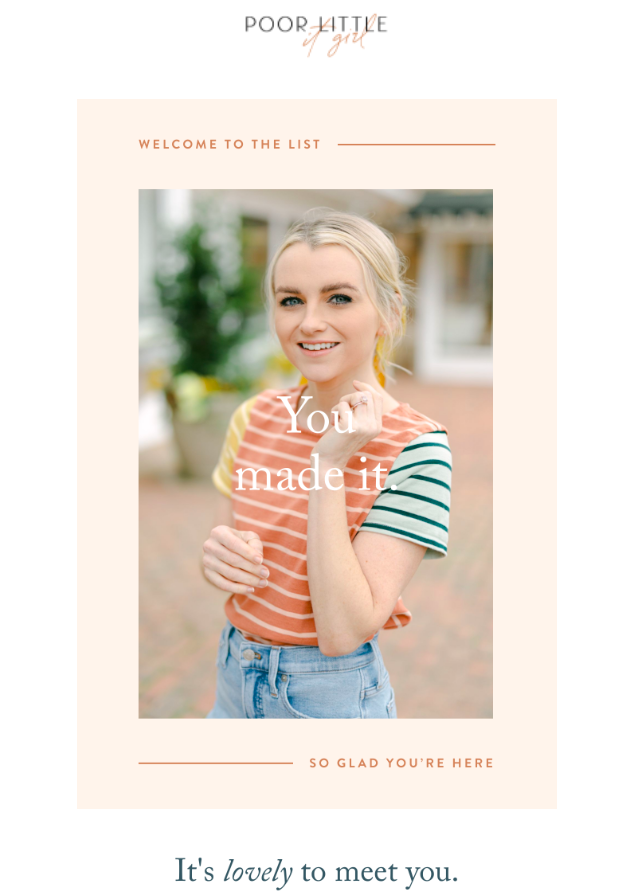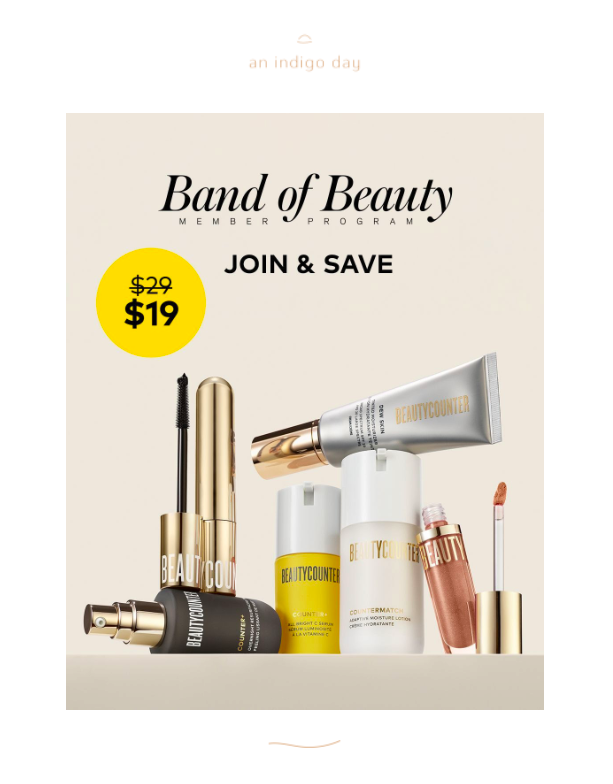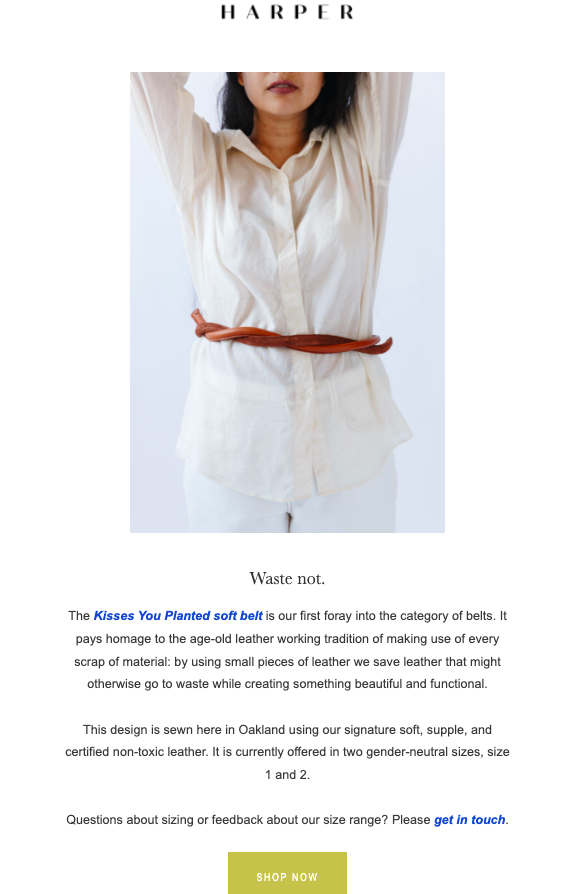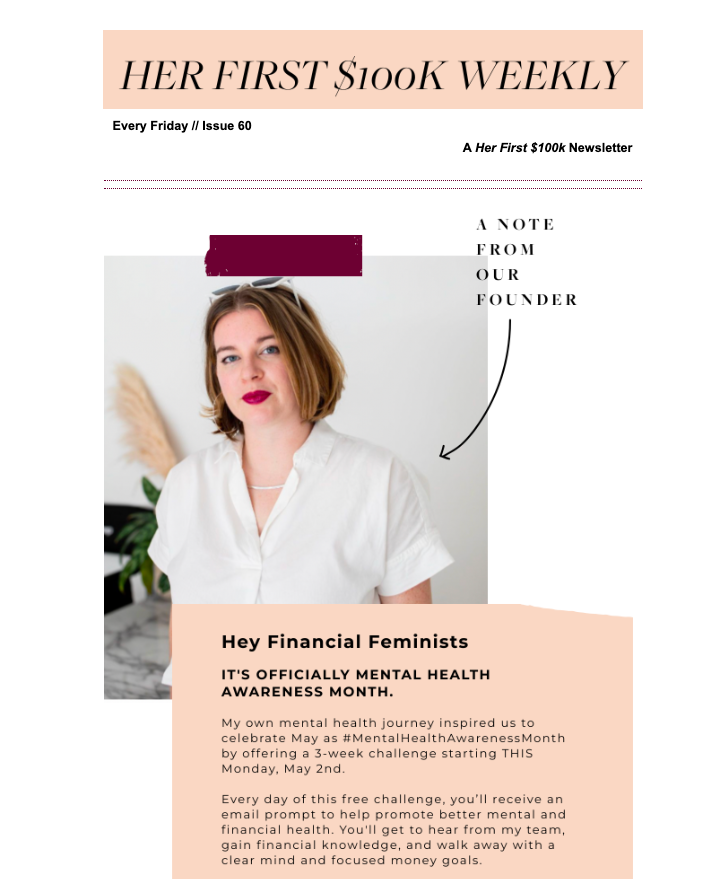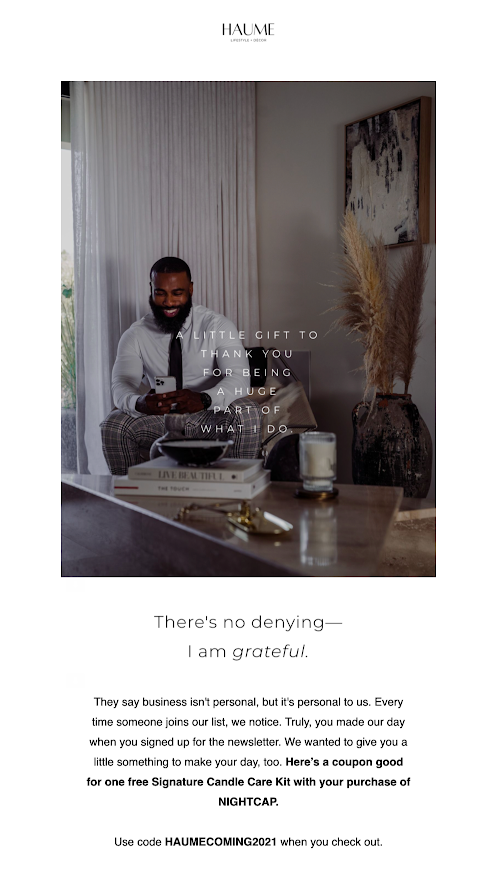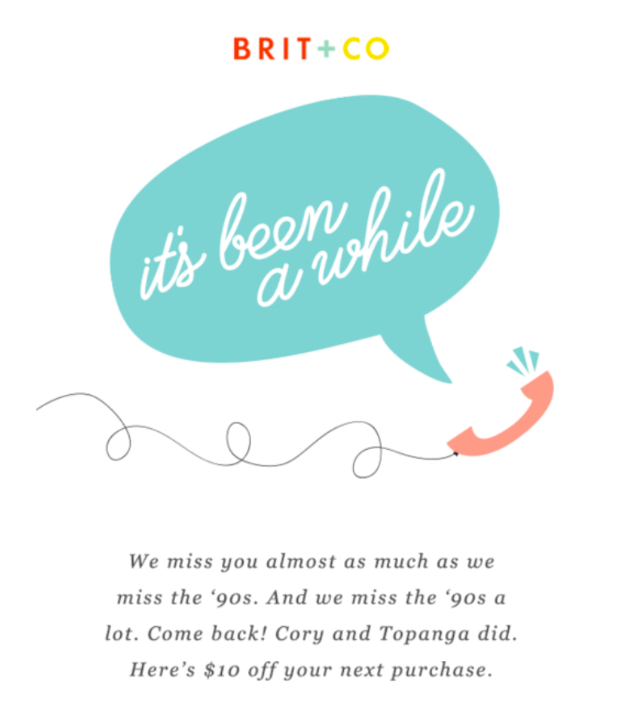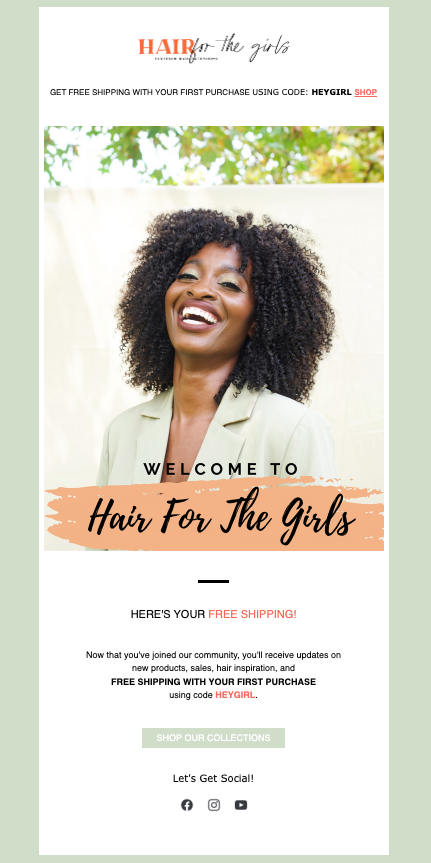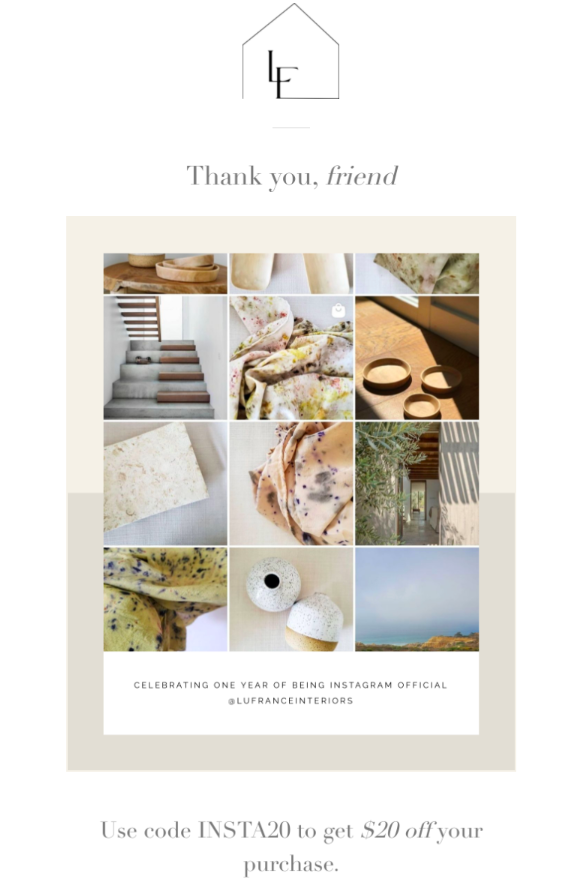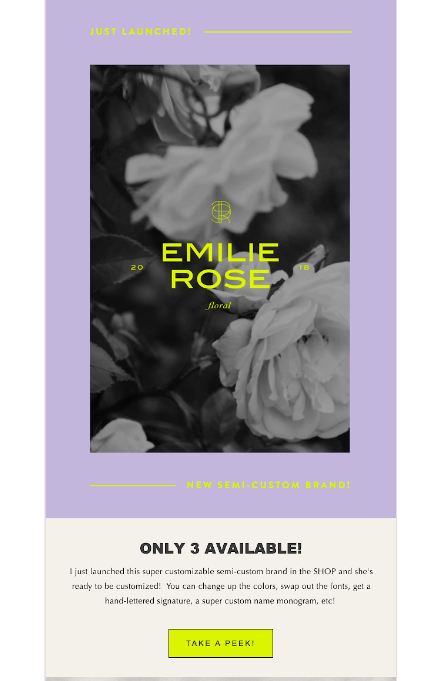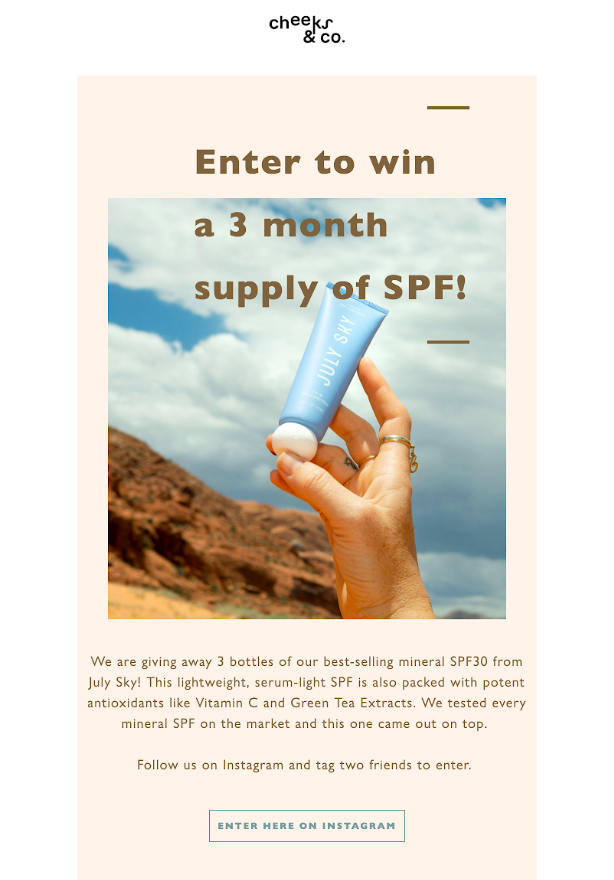8 Loyalty Program Email Examples & Templates to Connect with Customers
Table of Contents Jump to:
Jump to:
Table of contents
Wondering how to get customers to love your brand? Want them to refer your business to their friends and family?
It’s all about building customer loyalty, and one of the best ways to do that is with email marketing.
Imagine for a minute that you discover a new brand and sign up to receive their emails. A welcome email arrives in your inbox and you’re immediately drawn to the beautiful design and feel a connection with the brand’s founder or purpose. Plus, they give you a coupon for your first purchase!
You continue to receive emails that add value. Sometimes it’s a newsletter with information you couldn’t get elsewhere, other times it’s a sneak peek of a new product or service. And they’re always giving you the best deals.
Before long, you feel like a VIP. You start choosing this brand over others, making regular purchases and referring friends and family—you’ve become a loyal customer!
To make this happen with your own customers, you need loyalty-building emails that include the following:
- Special offers, discounts, or coupons that are relevant and valuable
- Personal photos of yourself or your team members
- Beautiful design using on-brand colors, fonts, and graphics
- Copy that sounds like it’s coming from a human
- Intangible perks like early access, sneak peeks, or inside information
- Stories about your product, yourself, or your team members
- A clear call to action (CTA) button taking readers to your website or landing page
- Links to your social media profiles
Next, we’ll show you the different types of loyalty emails and eight real-life examples to get you started.
Get unlimited email sends & subscribers with Flodesk
We’ll never increase pricing because your email list is growing
Types of customer loyalty emails
Any email you send your customers can be considered a loyalty email—so long as you’re adding value. So let’s take a look at a few different types of emails, what they are and how to use them to build customer loyalty.
Welcome emails
As you might guess, welcome emails are used to welcome newcomers to your brand or community. They’re typically sent when someone subscribes to your newsletter or signs up for something else on your website—like the above example from Cathy over at Poor Little It Girl.
Here are a few tips for building customer loyalty with welcome emails:
- Use welcoming language like “welcome to the list” or “we’re so glad you’re here” to communicate acceptance and belonging.
- Include a personal photo of yourself or your team to make an emotional connection with the reader.
- Automate your welcome emails so that new subscribers receive your message immediately after signing up.
Want more subscribers to send welcome emails to? Read: 11 Email Marketing Lead Generation Tactics Your Subscribers Will Love.
Special offer emails
Loyalty programs are all about the perks! In this email from Jessica over at An Indigo Day, she shares a special deal with her subscribers so they can save $10 on a Band of Beauty membership. Here are a few tips for sending special offer emails:
- Make sure the offer is relevant and valuable to the reader. Oftentimes, this means you need to segment your emails so you can send targeted offers to different groups.
- Include clear CTA buttons and links so that loyalty program members can easily redeem the offer or participate in your rewards program.
- Communicate that it’s a special offer for subscribers only as this will increase feelings of loyalty and the perceived value of remaining on your list.
Product update emails
Another perk you can extend to your customers to inspire loyalty is insider access to product launches or updates. This email from Harper The Label is a great example. Here are a few tips for product update emails:
- Include an image of the new product whenever possible, like Harper does above.
- If it’s a product update, explain how the new product improves upon the existing one and why it’s good for your customers. A story can be a powerful tool here. Not only will it explain the purpose behind the update, but it can also make customers feel like they have “behind-the-scenes” access to your team.
- Always include on-brand CTA buttons or links so that loyal customers can easily visit your website or landing page to make purchases.
Learn more about product update emails: 10 Product Update Email Template Examples & Best Practices.
Newsletter emails are great for loyalty programs because they give customers the inside scoop on your business. Tori from Her First 100k uses this newsletter email to invite her community members to join her in a 3-week challenge to promote better mental and financial health. Here are a few tips on building loyalty with newsletter emails:
- Send them on a regular basis (but not too frequently). As a point of reference, 61% of subscribers would like to receive brand emails every week.
- Use automation to help you get the most out of your newsletters for the least amount of effort. This involves setting up an automated email sequence, called a workflow, that sends emails to your subscribers at specific times or in response to specific inputs.
- Share high quality content that’s relevant and valuable for your audience. This can include actionable advice, helpful article recommendations, and tools to stay inspired and productive.
Thank you emails
In this thank you email from Haume, a lifestyle and home decor brand, new subscribers are rewarded with a free gift. Here are a few tips for building loyalty with thank you emails:
- To make your “thank you” sound sincere, use welcoming language and write in the same way you would talk to the reader in person.
- Use thank you emails to create a good customer experience, similar to what people are used to when shopping in person. Brands with superior customer experience bring in 5.7 times more revenue than those without.
Check out our favorite thank-you email templates for e-commerce!
Re-engagement emails
A re-engagement or win-back email is a marketing email sent to inactive subscribers, or to subscribers who don’t open or click your emails anymore. Its aim is to bring back people who’ve stopped engaging with your emails.
This re-engagement email from lifestyle brand Brit & Co. uses a dash of nostalgia along with a $10 coupon to draw customers back in. Here are some tips for using re-engagement emails to bring back loyal customers:
- Take the time to craft the perfect subject line. If your subscriber hasn’t been opening your emails lately, you’ll have to come up with something that grabs their attention right away.
- Provide something of value in your email. One of the most common offers you’ll find in a re-engagement email sequence is a discount code for between 10-20% off a purchase.
- Give subscribers a chance to change their preferences. Maybe they don’t want to receive as many emails, or maybe they’re ready to unsubscribe. It’s never fun to lose subscribers, but it can ultimately be a good thing—your email list might be a little smaller, but it’ll be full of better quality subscribers.
Want more details on re-engagement emails? Read: How to Write a Re-Engagement Email to Win Back Lost Subscribers.
Get unlimited email sends & subscribers with Flodesk
We’ll never increase pricing because your email list is growing
8 loyalty program email examples
Now that you know the different types of loyalty program emails, here are some real-life examples to get you started.
1. Hair For The Girls welcome email
In this email from Hair For The Girls, co-owners Yvette and Lindsay welcome new subscribers with a coupon for free shipping on their first purchase. Here’s why this email works:
- It makes a great first impression on readers thanks to the beautiful design and on-brand colors and fonts.
- It rewards new subscribers with a discount code that’s on-brand and easy to remember (HEYGIRL), creating a positive customer experience.
- It makes shopping easy by including a link at the very top of the email plus a clear CTA button at the bottom.
In this loyalty-building email from The Little Posy Co, the company shares images of and stories about their growers with their subscribers. Here’s why this email works:
- It uses beautiful, eye-catching photos to break up the longer sections of text and encourage readers to keep scrolling. (Seriously, those hydrangeas!)
- It reminds people of the brand’s dedication to sourcing its flowers locally—which is a good move, considering 79% of Americans say they’re more loyal to purpose-driven brands than traditional ones.
- It’s a monthly installment of a regular newsletter, so customers are expecting to receive it and probably looking forward to it. In fact, 90% of customers want to receive newsletters “at least monthly,” and just over 60% of those want emails “at least weekly.”
3. Moodelier’s special offer
This email from the creatives over at Moodelier rewards loyal subscribers with a special limited-time offer of 15% off all bundles and moodscapes. Here’s why this email works:
- It grabs readers’ attention with bright, bold colors that are on-brand and complementary to the product image.
- It delivers the entire message in a single glance—a good thing considering people spend an average of just 10 seconds reading a brand email.
- It features a single, clear CTA button encouraging readers to “Shop Now.” We recommend using only one CTA whenever possible (and never more than three). If you have multiple CTAs encouraging multiple actions, the reader can get overwhelmed with choices and abandon the whole thing.
4. Lu France Interiors’s milestone celebration
In this email from the artisanal home decor brand Lu France Interiors, loyal subscribers are invited to join them in celebrating one year of being “Instagram official.” Here’s why this email works:
- By leading with the phrase “Thank you, friend,” the email manages to communicate the purpose of the email while still leaving a bit of mystery so that readers continue on.
- The $20 off discount is likely to have a high perceived value for most customers, making them feel appreciated and valued.
- It makes customers feel like they were part of the journey, building a sense of community.
Saffron Avenue’s product update
This email from branding agency Saffron Avenue gives loyal customers a first peek at a new, limited edition product. Here’s what makes this email work:
- It creates a feeling of exclusivity and makes customers feel valued by giving them early access to a new product launch.
- Its copy communicates a feeling of urgency with the combination of “Just Launched!” “New Semi-Custom Brand!” and “Only 3 Available!”
- The unique, actionable language used in the CTA (take a peek) tells readers exactly what will happen if they click through.
For more inspiration, check out these examples of great teaser email campaigns for your next product launch or update!
6. Harper The Label’s “thank you” email
In this email from Claire over at Harper The Label, she celebrates one year in business and thanks subscribers for helping her get there. Here’s why this email works:
- It uses a sincere, personal message of gratitude to connect emotionally with readers. Plus, it’s signed “In gratitude” and features a personal signature from the brand’s founder.
- It communicates a sense of a shared journey, making subscribers feel like they’ve been a part of something.
- It doesn’t try to sell the reader anything, adding to the sincerity of the email.
In this email from Cheeks & Co, the skincare brand invites customers to enter a contest to win a three-month supply of SPF lotion. Here’s why this email works:
- Contest emails have the highest average open rate compared to other email campaigns.
- To enter the contest, customers need to follow Cheeks & Co on Instagram, which will open up another channel for engagement.
- It uses a relatively high-value prize to entice readers to take action—often necessary when running a contest or starting a customer loyalty program.
8. Allison Patel Photography’s “follow-up” email
In this email from Allison Patel Photography, she follows up with readers to see if they’ve taken action on an assignment from a previous email (choosing and displaying family pictures). Here’s why this email works:
- Allison shares that she hasn’t completed the assignment either because it’s hard and takes a lot of time. In doing so, she immediately makes a connection with readers because she’s going through the same thing they are.
- It creates a shared journey, making readers feel like they’re going through this project with someone else.
- The end result of this project will always remind readers about Allison and her business, building a strong sense of loyalty and community.
Get unlimited email sends & subscribers with Flodesk
We’ll never increase pricing because your email list is growing
Best practices for customer loyalty emails
In this section, we’ll go over five best practices to keep in mind when creating your own customer loyalty emails.
Use personalized subject lines
Getting recipients to open your email is the first hurdle you face in the inbox, and it often hinges on the subject line. In fact, 47% of recipients choose to open emails based on the subject line alone. To clear this hurdle, send targeted emails with personalized subject lines—it can increase email open rates by up to 50%.
Design your emails for scannability
Even the most loyal of customers don’t read every word of a promotional email. Instead, they scan it.
So, it’s a good idea to use graphics, subheads, bulleted lists, and other formatting tricks to create a beautiful email that’s easy to scan. For example, Flodesk’s Chief Creative Officer Rebecca Shostak recommends putting a 20-40 pixel spacer between each block in your email to create a light, airy feel to your design.
Send relevant special offers
91% of people choose brands that remember them and provide relevant offers and recommendations. To do this, segment your subscribers into groups based on their interests, demographics, and other factors. Then send separate, relevant offers to each group when the time is right.
Add value in multiple ways
Loyalty programs are all about creating value for your best customers. This can mean monetary value in the form of discounts, coupons, or special offers. But it can also mean intangible value in the form of newsletters, early access, or exclusive benefits. The best loyalty programs use a good mix of everything to make customers feel special.
Stay on top of your metrics
Metrics like your open rate and conversion rate can tell you a lot about whether customers are engaging with your loyalty program. Luckily, as a small business owner, you don’t have to be a data expert to use email analytics. With a good email marketing service (like Flodesk!) you can easily check your metrics on a regular basis.
Send beautiful loyalty program emails today
If it’s beautiful emails you’re after, look no further than Flodesk, the email marketing platform that helps small business owners streamline the email design process so they can focus on what’s most important—building customer loyalty.
With an intuitive drag-and-drop email builder, stunning forms, and powerful workflow automations, Flodesk can help you easily create beautiful emails, grow your subscriber lists, and nurture great relationships with your customers.
Loyalty program email FAQs
How do you announce a loyalty program?
One of the best ways to announce your loyalty program is by using your website or blog. Not only is it free, but it will also attract customers who are already interested in your product. If you’re launching a loyalty program that’s in addition to your newsletter or subscription list, you can also announce it via email to current subscribers.
What is a loyalty email?
Loyalty emails come in all different shapes and sizes, from welcome emails to special offers to product updates. The thread that connects them all, however, is that a loyalty email provides customers or subscribers with some type of value that no one else gets.
Why send customer loyalty emails?
The benefits of sending loyalty emails include increased purchase frequency, higher customer lifetime values, better customer engagement, stronger customer relationships and more referrals.
